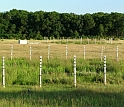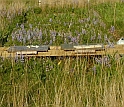News Release 06-062
Higher Carbon Dioxide, Lack of Nitrogen Limit Plant Growth
Stunted plants may not soak up excess carbon dioxide from the atmosphere

Scientists study purple lupines and other flowers and grasses in an experimental plot.
April 12, 2006
This material is available primarily for archival purposes. Telephone numbers or other contact information may be out of date; please see current contact information at media contacts.
Earth's plant life will not be able to "store" excess carbon from rising atmospheric carbon dioxide levels as well as scientists once thought because plants likely cannot get enough nutrients, such as nitrogen, when there are higher levels of carbon dioxide, according to scientists publishing in this week's issue of the journal Nature.
That, in turn, is likely to dampen the ability of plants to offset increases in atmospheric carbon dioxide.
"We found that atmospheric carbon dioxide levels may rise even faster than anticipated, because ecosystems likely will not store as much carbon as had been predicted," said Peter Reich of the University of Minnesota, lead author of the study, which was conducted at the National Science Foundation (NSF)'s Cedar Creek Long-Term Ecological Research (LTER) site in Minn.
"As a result, soils will be unable to sustain plant growth over time [as atmospheric carbon dioxide continues to increase]," said plant ecologist David Ellsworth of the University of Michigan.
Estimating the role of terrestrial ecosystems as current and future sinks--or storage places--for excess carbon dioxide hinges on an ability to understand the complex interaction between atmospheric carbon dioxide and nitrogen in soils, the scientists believe.
The six-year study, the longest of its kind, sheds light on the relationship between carbon dioxide emissions and plant productivity. In the experiment, scientists grew 16 different grassland plants in 296 field plots. The plots were exposed to both ambient and elevated carbon dioxide levels, and varying levels of nitrogen.
The study was designed to document plants' ability to grow and flourish in nitrogen-depleted soil, which, scientists believe, will become more common as atmospheric carbon dioxide levels rise. Said Henry Gholz, director of NSF's LTER program, "The possibility that nitrogen availability will limit the stimulating effect on plant productivity expected as a result of higher atmospheric carbon dioxide concentrations has important consequences. Reich et al. provide convincing results from long-term studies of Midwestern prairie species under controlled experimental conditions that this will be the case under low-nitrogen conditions. Since the results are consistent with those from other studies of trees and agricultural crops, this suggests that nitrogen limitations in the future may be common in much of the world, despite widespread nitrogen pollution."
The Minn. study, with its range of species, provides a broad test of carbon dioxide and nitrogen interactions, said Reich. Previous studies have been done with a single or a few plant species.
The Cedar Creek LTER is one of 26 such LTER sites supported by NSF.
-NSF-
-
Using field plots, scientists test ecosystem responses to increased carbon dioxide levels.
Credit and Larger Version -
A bench allows scientists to take samples from the center of an experimental plot.
Credit and Larger Version
Media Contacts
Cheryl Dybas, NSF, (703) 292-7734, email: cdybas@nsf.gov
Related Websites
Cedar Creek LTER Site: http://www.cedarcreek.umn.edu
LTER Network: http://www.lternet.edu
The U.S. National Science Foundation propels the nation forward by advancing fundamental research in all fields of science and engineering. NSF supports research and people by providing facilities, instruments and funding to support their ingenuity and sustain the U.S. as a global leader in research and innovation. With a fiscal year 2023 budget of $9.5 billion, NSF funds reach all 50 states through grants to nearly 2,000 colleges, universities and institutions. Each year, NSF receives more than 40,000 competitive proposals and makes about 11,000 new awards. Those awards include support for cooperative research with industry, Arctic and Antarctic research and operations, and U.S. participation in international scientific efforts.
Connect with us online
NSF website: nsf.gov
NSF News: nsf.gov/news
For News Media: nsf.gov/news/newsroom
Statistics: nsf.gov/statistics/
Awards database: nsf.gov/awardsearch/
Follow us on social
Twitter: twitter.com/NSF
Facebook: facebook.com/US.NSF
Instagram: instagram.com/nsfgov




